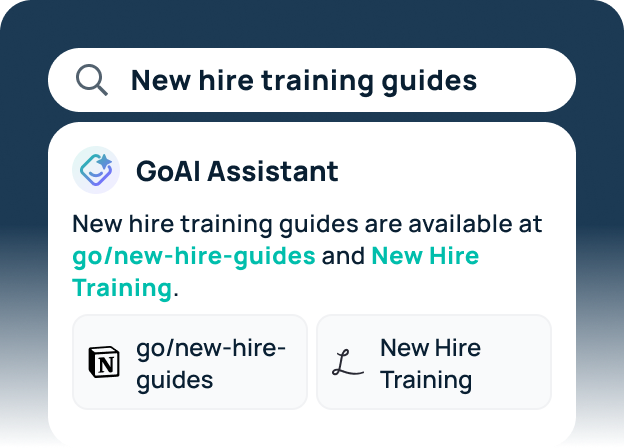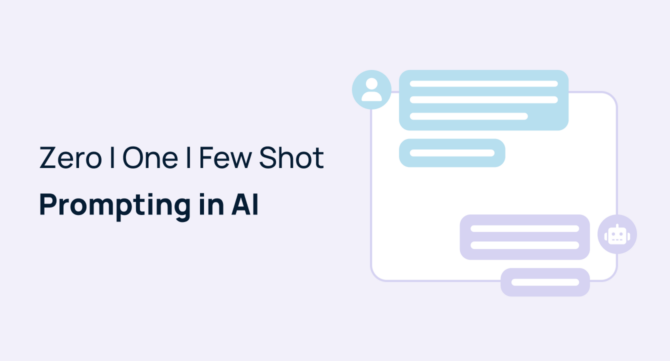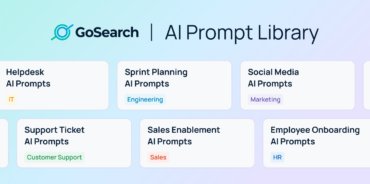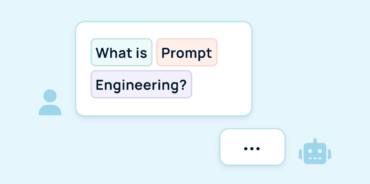Artificial Intelligence (AI) continues to transform industries, and one of the key advancements is the ability to generate accurate and context-aware responses using AI prompts. Among the many methods, three popular strategies stand out: zero-shot, one-shot, and few-shot prompting.
Understanding the nuances of these techniques can greatly improve how businesses and individuals interact with AI. This blog will delve into the differences between zero-shot, one-shot, and few-shot prompting, provide relevant examples, and highlight how enterprise search software like GoSearch enhances effective prompt engineering.
What is Zero-Shot Prompting?
Zero-shot prompting refers to the technique of querying an AI model without providing any prior examples or context. Essentially, you ask the AI to perform a task it has not specifically seen before, expecting it to leverage its general understanding of the topic. Zero-shot prompting relies on the AI’s ability to infer meaning based on its pre-trained data.
Example of Zero-Shot Prompting
Suppose you want AI to summarize a complex legal document. You might give a prompt like:
“Summarize this legal document in simple terms for a layperson.”
Here, the AI is asked to perform the task with no specific examples of how to do it. It uses its pre-existing knowledge to identify key points and provide a summary without additional context. Zero-shot prompting is powerful for general queries and is particularly useful when you’re dealing with general-purpose topics.
Pros and Cons of Zero-Shot Prompting
Pros:
- Time-Efficient: No need to spend time creating examples or training data.
- Flexibility: Can handle a wide range of topics without customization.
- Versatile: Ideal for general-purpose tasks, making it suitable for quick inquiries.
Cons:
- Accuracy: Might produce less accurate results for complex or nuanced queries.
- Context-Limited: Without examples, AI may misinterpret the context or nuances.
- Potential Bias: Depends heavily on the pre-trained data, which might not cover specialized domains.
What is One-Shot Prompting?
One-shot prompting relies on providing the AI with a single example before it processes a task. This technique gives the AI some guidance on how to perform the task, which can improve accuracy and reduce ambiguity. A one-shot prompt is still relatively simple but gives more structure to the AI’s output.
Example of One-Shot Prompting
To see how one-shot prompting differs, consider the previous legal document summary example, but with a single example provided:
Prompt:
“Here’s an example summary of a legal document:
‘The document describes the terms and conditions for renting an apartment, emphasizing tenant rights and responsibilities. It simplifies legal jargon into plain language for better understanding.’
Now, summarize this legal document in a similar way for a layperson.”
This prompt offers a concrete format for the AI to follow, enhancing clarity and specificity. The AI now understands the style and content you’re looking for, likely resulting in a more tailored response.
Pros and Cons of One-Shot Prompting
Pros:
- Better Precision: Examples improve the model’s ability to follow instructions accurately.
- Greater Clarity: Reduces ambiguity by offering a clear example.
- Consistency: More reliable for generating structured and specialized outputs.
Cons:
- More Time-Consuming: Requires some preparation to create an effective example.
- Limited Scope: A single example might not cover the entire breadth of what’s needed.
- Possibility of Overfitting: The AI might overly mimic the example, limiting creativity.
What is Few-Shot Prompting?
Few-shot prompting takes guidance a step further by offering the AI several examples before asking it to perform a task. This approach helps the AI identify patterns across different contexts, making it more adaptable and accurate in generating responses. By seeing multiple examples, the AI can better grasp the style, tone, and format expected, which can result in more nuanced and contextually appropriate answers.
Example of Few-Shot Prompting
To illustrate how few-shot prompting works, let’s revisit the legal document summary scenario, but this time providing multiple examples:
Prompt:
“Here are a few example summaries of legal documents:
- Example 1: ‘The contract details the obligations of both parties in a freelance agreement, focusing on project scope, deadlines, and payment terms. It simplifies complex clauses to avoid ambiguity.’
- Example 2: ‘This document outlines the privacy policy of a company, highlighting data collection, storage practices, and user rights. It translates legal terminology into layman’s terms for easier understanding.’
- Example 3: ‘The lease agreement emphasizes tenant responsibilities for property maintenance, along with the consequences of lease violations. It breaks down legal language into straightforward guidelines.’
Now, summarize this legal document in a similar way for a layperson.”
This prompt provides multiple examples that show various ways legal content can be distilled into a clear, accessible format. With this guidance, the AI is likely to produce a more refined response, understanding the diversity of how legal documents can be summarized.
Pros and Cons of Few-Shot Prompting
Pros:
- Higher Accuracy: Multiple examples help the AI grasp more complex patterns, improving output quality.
- Contextual Nuance: The AI can better understand nuances and variation when more examples are given.
- Broader Adaptability: Increases the likelihood of generating relevant responses across diverse topics.
Cons:
- Preparation Effort: Requires crafting several well-thought-out examples, which can be time-consuming.
- Longer Prompts: Multiple examples make the prompt longer, which can increase processing time.
- Memory Constraints: In some cases, too many examples can exceed input limits, especially for larger tasks or detailed prompts.
Few-shot prompting strikes a balance between flexibility and precision, providing enough context to guide the AI effectively without overwhelming it with constraints.
Zero-Shot vs. One-Shot vs. Few-Shot Prompting: A Quick Comparison
| Zero-Shot Prompting | One-Shot Prompting | Few-Shot Prompting | |
| Context Provided | None | Single example | Multiple examples |
| Flexibility | High (general-purpose) | Medium example-dependent | Medium to high (more adaptable to examples) |
| Accuracy | Varies (depends on AI model’s training) | Higher (guided by example) | Even higher (patterns established) |
| Preparation time | Low | Medium (requires example) | High (requires multiple examples) |
| Best Use Case | Broad, general topics | Specific, nuanced tasks requiring guidance | Complex or varied tasks needing precision and context |
Use Cases in the Real World
Zero-shot, one-shot, and few-shot prompting each have practical applications across multiple fields. Here’s how each technique can be applied effectively:
Customer Support
- Zero-Shot Prompting: Ideal for handling generic FAQs, such as basic account inquiries, general troubleshooting, or common policy questions. It provides quick responses without the need for specific guidance.
- One-Shot Prompting: Useful for industry-specific queries, like providing legal, financial, or technical guidance. A single example can ensure responses align with specific terminology or standards relevant to the field.
- Few-Shot Prompting: Perfect for more complex or specialized support scenarios, like resolving advanced technical issues, interpreting nuanced legal documents, or troubleshooting detailed product problems. Multiple examples help tailor the response to different scenarios while maintaining accuracy.
Content Creation
- Zero-Shot Prompting: Great for generating quick ideas, brainstorming, or coming up with unique content without being constrained by a specific format. It’s excellent for creative, open-ended tasks like generating story prompts or catchy slogans.
- One-Shot Prompting: Best for tasks requiring consistency in tone or structure, such as creating articles that adhere to a specific style or following a defined content format. A single example can help the AI maintain a particular writing style.
- Few-Shot Prompting: Useful for ensuring adherence to a specific voice or tone across diverse topics. It’s particularly effective for creating content like technical guides, product descriptions, or blog series that require detailed, structured information. Multiple examples provide clarity on formatting and tone across varied contexts.
Data Analysis
- Zero-Shot Prompting: Effective for generating general insights from datasets, such as identifying key trends, summarizing data, or generating preliminary findings without specific formatting.
- One-Shot Prompting: Helps structure data interpretation in a specific format, such as summarizing financial reports or presenting analytics in a defined style. A single example can guide the AI to provide structured and precise outputs.
- Few-Shot Prompting: Ideal for detailed data analysis tasks requiring nuanced understanding, like comparing financial quarters, extracting insights from complex datasets, or creating customized visual reports. Multiple examples can show how to handle varied data sets, ensuring consistent interpretation across different types of analysis.
Each prompting technique has its strengths, allowing you to choose the most appropriate one based on the complexity and specificity of the task at hand.
Enhancing Prompt Engineering with GoSearch
Effective prompt engineering is about crafting the right questions or examples to get desired AI outputs. For organizations, managing these prompts can be complex, especially when dealing with large datasets or diverse sources. This is where enterprise search software like GoSearch becomes crucial.
GoSearch as a Tool for Prompt Optimization
GoSearch is designed to streamline information retrieval and organize vast amounts of data, making it an excellent partner for AI-powered prompt engineering. Here’s how GoSearch enhances the prompting process:
- Data Aggregation: GoSearch collects and indexes information from various internal and external sources, allowing users to search across multiple databases seamlessly. This provides a comprehensive background to design more effective prompts.
- Real-Time Feedback: GoSearch allows businesses to analyze how prompts perform over time, tracking which ones yield the best AI responses. This feedback can then refine prompts for future interactions.
- Contextual Relevance: By leveraging GoSearch’s ability to filter and prioritize relevant information, users can design prompts that are contextually accurate, whether for zero-shot, one-shot, or few-shot applications.
To learn more about prompt engineering within GoSearch, read our guide: What is Prompt Engineering? Why it Matters + Use Cases
Prompt Engineering: An Essential AI Skill
Zero-shot, one-shot, and few-shot prompting are essential tools in the AI toolkit, each with unique strengths and applications. Zero-shot is perfect for handling broad and general tasks, while one-shot and few-shot excel when precision and consistency are required. By understanding the differences and deploying the right strategy for the right scenario, users can maximize AI’s potential.
Tools like GoSearch elevate prompt engineering by organizing data, customizing prompts, and offering real-time feedback. As businesses continue to embrace AI, mastering these techniques and leveraging enterprise tools will lead to more efficient and effective AI interactions.
By refining how we prompt AI, we can ensure that our AI systems deliver the quality, accuracy, and relevance needed for modern applications. Whether it’s zero-shot, one-shot, or few-shot, the key lies in understanding the task, the context, and the desired outcome.
Search across all your apps for instant AI answers with GoSearch
Schedule a demo
FAQs
What is zero-shot prompting?
Zero-shot prompting is a technique where an AI model is given a task without any prior examples or context. It relies on the AI’s pre-existing knowledge to interpret and respond based on the prompt alone.
How does one-shot prompting differ from zero-shot prompting?
One-shot prompting provides the AI with a single example as a guide before it performs the task. This example helps clarify the expected output, making the AI’s response more accurate and context-specific.
What is few-shot prompting?
Few-shot prompting involves providing the AI with several examples before giving it a task. These multiple examples help the AI recognize patterns, styles, and specific contexts, leading to more accurate and nuanced responses.
What are the advantages of zero-shot prompting?
Zero-shot prompting is quick, flexible, and efficient for general queries, as it requires no examples or training data preparation. It is useful for broad topics and exploratory tasks.
When should I use one-shot prompting instead of zero-shot prompting?
Use one-shot prompting when a task requires specific guidance or when the output needs to follow a particular format or style. It is ideal for scenarios where accuracy and clarity are essential, such as technical documentation or specialized content.
When is few-shot prompting the best option?
Few-shot prompting is best for complex tasks that require accuracy and context, such as detailed technical analyses, varied customer support scenarios, or content creation with specific stylistic needs. It is particularly effective when multiple contexts or nuanced interpretations are needed.
What are some common use cases for zero-shot prompting?
Zero-shot prompting is frequently used in customer service for general inquiries, content generation for brainstorming ideas, and data analysis for broad pattern recognition.
What are common use cases for one-shot prompting?
One-shot prompting is useful for structured outputs like report summaries, specific industry-related customer inquiries, or adhering to a particular format in content creation. It excels in scenarios where one clear example can define the desired output.
What are common use cases for few-shot prompting?
Few-shot prompting is ideal for tasks that require handling diverse contexts or complex information, such as drafting legal documents, performing in-depth data analysis, or generating comprehensive technical guides. It’s also valuable for creating content series with consistent style across multiple pieces.
Can zero-shot prompting lead to inaccurate results?
Yes, zero-shot prompting can sometimes produce less accurate results, especially for complex or specialized topics, as it lacks contextual guidance. The AI might misinterpret nuances or miss out on specific details.
How does providing a single example in one-shot prompting improve AI responses?
A single example helps reduce ambiguity by showing the AI what is expected. It acts as a template, guiding the AI to understand the task’s context, style, and format, leading to more precise and consistent outputs.
How does few-shot prompting enhance AI accuracy?
By providing multiple examples, few-shot prompting enables the AI to identify patterns and variations in style or content. This improves accuracy by allowing the AI to learn from diverse scenarios, making it more adaptable and capable of handling complex or detailed tasks.
What are the limitations of one-shot prompting?
One-shot prompting can be time-consuming to prepare and may limit the AI’s creativity if it overfits to the provided example. It also might not fully capture complex requirements if only one example is used.
What are the limitations of few-shot prompting?
Few-shot prompting requires more preparation time, as multiple examples need to be crafted. It can also increase the length of the prompt, which may affect processing time and potentially exceed input limits for extensive tasks.
How does enterprise search software like GoSearch support prompt engineering?
Enterprise search software like GoSearch aids prompt engineering by organizing vast datasets, providing contextual relevance, and enabling the creation and refinement of effective prompts. It helps users access relevant data quickly, making zero-shot, one-shot, and few-shot prompting more effective.Can zero-shot, one-shot, and few-shot prompting be combined for better results?
Yes, a hybrid approach can be beneficial. Start with a zero-shot prompt to explore general responses, use one-shot prompting to establish a basic format, and then refine with few-shot prompting for detailed guidance. This combination balances flexibility with accuracy, leading to more robust AI interactions.

















